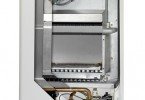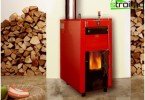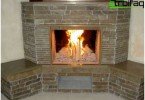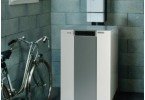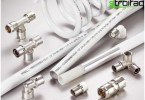Bimetallic radiators (batteries) for heating
With the onset of cold weather, more and more people are thinking about reliable heat supply to their homes, about replacing old ones. heating batteries (often cast iron) to new ones. In such a situation, it is important to navigate and choose the optimal ones from the whole variety of heating appliances of different price ranges and technical characteristics. Bimetal heating radiators are quite affordable for the middle class, have a number of advantages, and may become the most preferred option for many.
Content
- Characteristics of Bimetal Batteries
- Reviews and expert opinion
- Bimetal heating radiators: how to choose?
- Calculation of the number of sections
- Market-leading batteries detail on the merits
Characteristics of Bimetal Batteries
A bimetallic radiator is a steel manifold, under high pressure, poured into an aluminum casing (a cross between sectional aluminum and tubular steel), the technical characteristics of which can be different (it depends on one or another manufacturer). Possible ranges:
1. Distance between axles: from 350 to 500 mm
2. Dimensions (height / width / depth): from 425 mm to 580 mm / 80-82 mm / 77-95 mm
3. Maximum working pressure: from 16 to 35 atm
4. Thermal power: from 120 to 190 W
5. The volume of water in the section: from 0.15 to 0.38 l
6. Maximum temperature of the heat carrier: from 110 to 130 gr. FROM
7. Weight: 1.22 to 1.97 kg
8. Warranty: up to 20 years
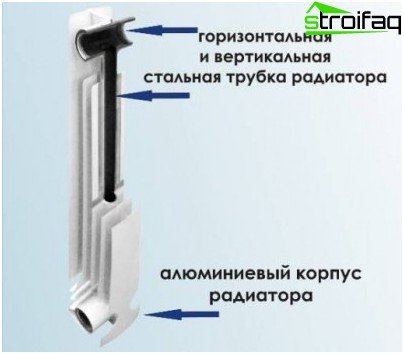
Bimetal heating radiator: indoor unit
Reviews and expert opinion
Manufactured using modern technologies, these devices are in good standing with specialists in the field of heat supply, which distinguish their undeniable advantages such as:
- high efficiency in houses where there is central heating (steel pipes of the collector are most adapted to pressure differences in the heating system);
- good resistance to corrosion, a high degree of resistance to the aggressive environment of the coolant;
- excellent heat transfer characteristics (up to 190 W);
- good heat conductivity, heat up quickly and easily;
- modern design of the aluminum case;
- strength (can withstand pressure up to 35 atmospheres);
- durability (up to 20 years); compactness.
The main disadvantage of radiators of this type is one: the price is 15-20% higher than the price of aluminum analogues.
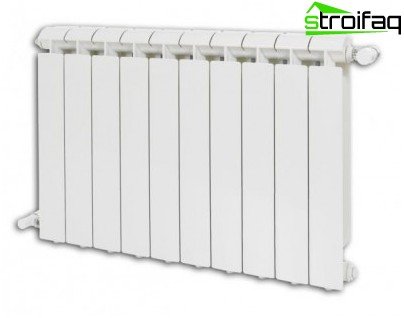
Its performance depends on the number of sections of the bimetallic radiator, but at the same time as the increase in these components, the complexity of maintenance
Bimetal heating radiators: how to choose?
In the conditions of a particular house, not all radiators can be suitable for work.
Therefore, first you need to find out all the main indicators that characterize the heating system of your home, for example, in the housing department for residents of urban high-rise buildings. Need to inquire about:
- value of working pressure;
- the value of the pressure (test) pressure;
- heating system designs – two-pipe or one-pipe (this information will be needed when installing batteries);
- the diameter of the supply pipes to the existing batteries;
- coolant used in the system (if water is used, its temperature is important).
Radiators should be selected based on 3 main parameters: heat transfer, ability to withstand the necessary pressure and design.
1. Pressure. Immediately discard those whose pressure indicators are less than those set in your home. They should also be designed for ultimate test pressure (that is, pressure is “at limit”). In this regard, bimetal heating batteries are very reliable. Indeed, some models can withstand up to 35 atmospheres. This is despite the fact that in an old brick house (no more than five floors) the pressure will be no more than 8 atm, in a modern panel nine-story building – 9 – 10 atmospheres. Therefore, it is better to install bimetallic batteries where additional reliability is required: in high-rise buildings on the upper floors or in factories.
2. It is also important heat transfer (thermal power). The “deeper” and lower the radiator, the more achievable a uniform temperature distribution in the room, as well as – more efficient heating of the entire air volume. Choose batteries with greater depth, all the more important if you intend to install it in a niche. The distance between the floor surface and the lower part of the device must be at least 60 mm, the gap between the window sill and its upper part – at least 100 mm. Calculate the width of the radiator that you plan to place under the window, less than 50 – 75% of the width of the opening. Otherwise, it will not be possible to create a “thermal curtain” with a stream of warm air, and the cold air coming from the window will fall into the room on both sides of the radiator.
3. Design This device is also important. Its appearance should correspond to the interior of the room. All differences in the design depend mainly on the dimensions of the interaxal distances, which are usually 350 or 500 mm.
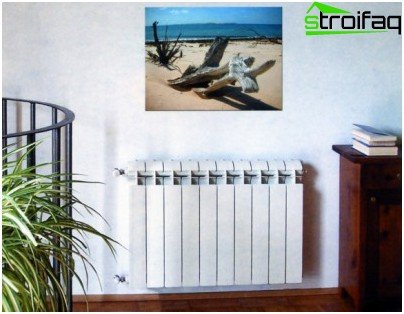
Bimetal radiator fits perfectly into any interior
Calculation of the number of sections
Bimetallic radiators consist of separate sections, which are interconnected by means of special gaskets made of paranit, silicone and heat-resistant rubber. For each room, the required number of sections is selected based on its area and heat transfer from one section of the radiator. When calculating the following factors should be taken into account:
- climatic conditions of the region;
- coolant temperature (usually water);
- possible heat loss.
We take into account climatic conditions
The power output of 1 heating battery should be 100 watts per square meter.
Depending on the model of the bimetallic radiator and its manufacturer, the thermal power of one section can be from 120 to 190 W.
Accordingly, if we need to heat a room of 10 square meters, then it is advisable to purchase a 9-10-section radiator with a power of one section of 120 W or 5-6-section with a power of one section of 190 W.
Important! Do not strive to buy multi-section radiators (more than 10 sections). For ease of maintenance, it’s best to buy a few batteries with few sections..
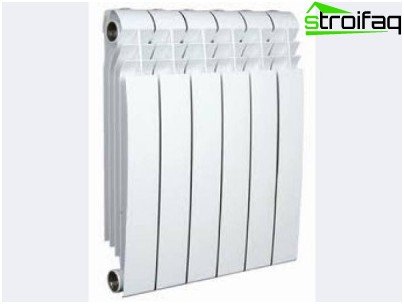
The best option for citizens is a bimetallic radiator with six sections
We take into account heat loss
All the main heat losses to which living quarters are subject to are: heat leaving through the windows, as well as through the walls and lost along the way to the batteries.
It is worth considering that:
- the greatest heat loss is usually in a corner room;
- sometimes up to 75% of heat can go through the windows (this depends on the profile used, its quality);
- in a room with 2 windows there is more heat loss, therefore it is necessary to install more radiator sections in it;
- at a temperature of the heat carrier (usually water) less than necessary for heating the room, it is advisable to install a larger number of sections (by about 10 or 30%);
- if you plan to regularly ventilate the room in winter, then radiators should be taken with a margin – more by 1 or 2 sections.
Important! If possible, install thermostats on the battery. Depending on the actual room temperature, they will adjust the temperature of the radiator automatically. You can always maintain optimal temperature conditions.
When calculating sections, it is better to proceed from one simple rule: excess heat is better than its lack. Winters are unpredictable, and in central Russia they can be very frosty. Therefore, the calculation of bimetallic radiators is best done with a margin. If the means do not allow thermostats to be installed, then try to install at least a tap on the bypass and a tap blocking the water supply. By blocking one tap halfway and completely closing the other, it is possible to regulate the heat transfer of the radiator smoothly.
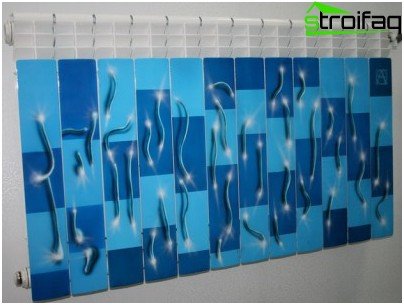
Bimetal heating radiator: original design
Market leading batteries
The best are the “right” radiators, in which all the internal parts in direct contact with the coolant are 100% made of steel, and the best is made of stainless steel. Due to this, high corrosion resistance is possible (since stainless steel is not subject to corrosion) and resistance to pressure drops. As a rule, Italian manufacturers, for example, Royal and Global Style firms, are famous for high-quality radiators. The actual service life of such units reaches 40-50 years.
But many Chinese firms, and some domestic manufacturers, make only a small part of the internal parts of these heating devices from steel. What is the result? And the fact that the coolant is in contact with the connection points of aluminum and steel, reducing the corrosion resistance of the radiator. In such a semi-metallic unit, by and large, there is no special sense, since the processes of metal corrosion in it are no less intense than in aluminum counterparts, and there is nothing to overpay for. Indeed, the main advantage of bimetallic devices over aluminum ones is that the former have increased corrosion resistance, which means durability. It is known that the coolant medium can be extremely aggressive, capable of destroying the walls of a heating device in a matter of years. Therefore, try to purchase bimetallic batteries from trusted manufacturers, do not buy by hand, check the technical specifications and warranty obligations of the manufacturer.
In conclusion, we note that the bimetallic radiator has many advantages. The main thing is to choose the right device that is suitable specifically for your room. To avoid problems with the installation, you should determine its dimensions in advance, find out the diameters of the supply pipes and get a diagram of their connection to the radiator: from the floor (one pipe or both) or from the bottom of the baseboard or floor, from the back of the wall, side, top. When repairing and replacing these heating devices, it is important to know the exact center-to-center distance measured between the holes to which the supply will be made. If you accurately possess all this information, then you will be able to avoid unnecessary costs and hassle associated with installing different adapters, this will facilitate the selection of necessary accessories.


